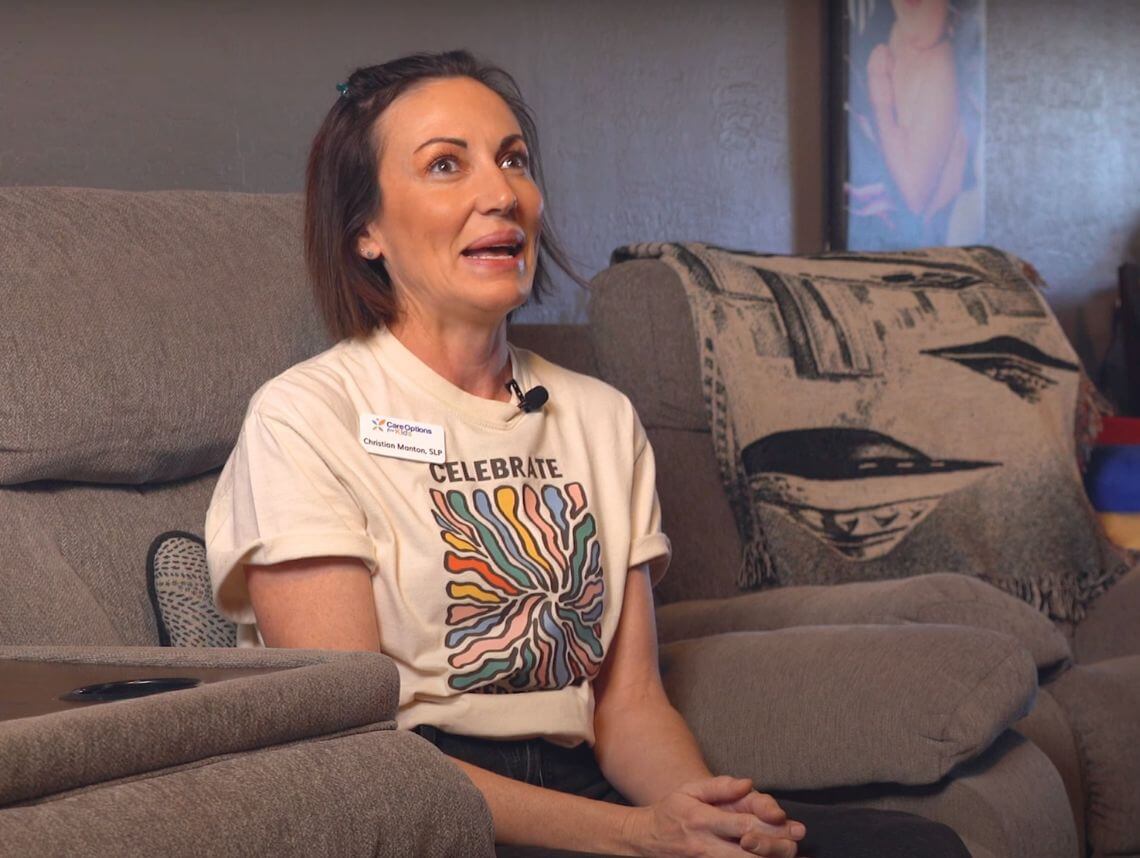Solace Blog
- Activities19
- Autism & Behavioral4
- Community154
- Early Intervention71
- Events & Giving Back20
- Extraordinary Kids22
- Family Caregiver4
- Home Care Therapy60
- News93
- Parent Articles83
- Patient Testimonial21
- Pediatric Therapy76
- Pediatric Therapy Career46
- Private Duty Nursing1
- School-Based Services1
- Telehealth Therapy27
- Tips & Advice66
Sensory Activities For Kids

From School To Home: Christian’s Shift To Impactful Therapy
Speak, Listen, Connect: 6 Communication Strategies for Therapists
Your 5-Minute Mindfulness Break: 5 Simple Ways to Recharge Between Therapy Sessions
The Transformative Power of Occupational Therapy: Peter Leypold’s Journey

Our Response to COVID-19 and Our Transition to Telemedicine
Last month we sat down with our CEO, Darcie Peacock, to discuss the changes we’ve faced as a result of the COVID-19 pandemic, and how it has impacted our families and therapists. We are dedicated to providing the highest-quality care to the kids we work with, and Telemedicine has afforded us the ability to continue this level of care, and even increase the benefits to families who have limited access to therapists.
Question: Are you currently providing 100% telemedicine, or still providing in-home visits?
We moved to 100% telemedicine on Saturday, March 14th in response to COVID-19 social distancing guidelines. It was a very big shift. We had been planning to launch a telemedicine program later in the year, so we had the framework ready, but hadn’t gone through all the steps and training. In meetings with State and industry agencies, we knew COVID-19 was coming quickly and would greatly impact the access to needed therapy for our 4,000 + children; as well as every other child in CO. As a team, we started meeting and figuring out how to make the switch very quickly. I have the most amazing leadership team, and everybody just put all hands on deck to ensure we were prepared to provide the same quality of individual interactive therapy that we do in the home. On Friday, March 14th we completed the last home visit and made the call to move to Telemedicine exclusively. On Monday, March 17th we made the call to make that switch. It has been more successful than we could have imagined and we are currently providing over 5,000 visits per week. A big piece of that puzzle in making it successful was our clinicians. And then, just embracing it and going with it and digging in to figure it out. The leadership team was definitely a big piece of supporting them, but really it came down to them trusting us and giving it a shot, and they just did a phenomenal job all week this week.
Our IT team checked all of the HIPAA-compliance boxes to ensure that our patients’ and clinicians’ privacy would continue to be protected; as well as provided iPads with service to our families without access, our clinical team pulled together resources for successful transitions, our Patient Access and Billing Teams quickly pulled together policies, and our Business Development team created informational resources for our patients, families, and community/physician partners. It was critical for us to share that “Solace is still open for business,” accepting referrals, providing essential care for our patients, and stepping up to fill in a huge gap within the community while daycare, Early Intervention and school closures headlined the news.
Question: How has the roll out gone – have there been any challenges? Any big wins?
There was sort of this initial moment of “ok, this is happening, this is what we’re going to do, and here’s the resources we have available.” And then it was a lot of smoothing out the bumps from there – there have definitely been a fair number of bumps. One example is, interpretation services. So, we serve families who speak a variety of different languages as their primary language. Spanish is a big one for sure. And, while we have a lot of Spanish-speaking clinicians, we also have some clinicians who aren’t fully fluent. There just wasn’t the availability of enough interpreters to meet the needs so quickly. So, we moved some of our other employees to train and assist and have been able to find other amazing resources.
The immense win for us has been the absolute collaboration and teamwork and the positivity through the roof. Just, everybody jumping into support each other, and offering any way that they can help has been really fantastic. Our team is really supportive of the decision that we made to go 100% telemedicine, and they are in this for the long haul.
Question: What are the main differences between in-home and telemedicine?
All of our services (we really focus on parent education), and what we like to say is, our clinicians are very skilled and they are wonderful at what they do, but they are not miracle workers. Even when we’re coming into the home, we’re only going to make so much progress towards our goals if the only time we’re working on those is that one time a week, or two times a week, for a short duration of time. So, we’re always focused on engaging with the parents and talking about, “what are the challenges you are seeing? How can we best support you to meet the goals you have for your child,” and then giving them strategies to do that work during the week, but as part of their normal routine. So, at dinner time if you maybe set up the plate like this, that could help achieve this goal. So we’re always working on those kinds of things. When you’re there, what’s interesting is, you feel like they’re doing great parent coaching. Once you’re on the other side of the screen and the parent is the one there, and you’re having to explain to them, “ok, if you put your hand just above their hip when they’re standing here at the side of the couch, that’s how you best support them, but they have to use their trunk strength,” for example. So then you’re really 100% parent coaching. I think the great part about that is that it’s very empower for the parents. And we found that parents really prefer this method because of that. Because they really get to be engaged. Especially right now, you know, families are at home, we might have been seeing their child in daycare, and now they get to be fully apart of the process, and really see how their kids are progressing which is really cool.
Telemedicine puts the parents and caregivers in the driver’s seat. Initially this can sound nerve wracking for the family; however, our families are loving it and found it is highly impactful and empowering. We always say: “you know your child best. My job is to coach you and make sure that you feel confident implementing these strategies throughout your daily routine.” The key here is also explaining to the family that just like in-person sessions, it will take a little trial and error. It will take some time to identify the best way to engage the patient and the caregiver virtually: does it work best to have the child engage directly with the device? Or does it work best to have the device out of sight for the child and work in an observation-coaching method with the parent so as not to distract the child?
Question: Who is remote therapy for?
It’s for everyone! It’s an excellent platform for successful occupational, physical, speech, behavior and feeding therapy services, offering access to families who might otherwise not have access to services. It’s for families who have immunocompromised children, for times when inclement weather can impact service delivery, for families traveling, for children who share time at different homes/locations throughout the week, It can be the primary delivery format or a format used on occasion. The great thing about remote therapy, is that just like in-person sessions, the platform, structure and resources can be tailored to the individual patient to make sessions most therapeutic and effective.
Question: Are there any drawbacks?
I think the only drawback right now has just been, how quickly we’ve had to make the change, but in terms of the actual medium of providing the service, this is a great option for many families and clinicians. Under normal circumstances – when COVID 19 quarantine is over – we will do what we have always done and lean on the clinicians to make the best judgment of what’s most appropriate, and support families, and what works best for them. But otherwise, it’s a really great way for kids to continue to make gains, and really to engage parents. And that’s with or without a pandemic.
Stay tuned for the rest of the interview to be published later this week and early next week, where we discuss the benefits of remote therapy, and what Solace is doing moving forward.
Share this Post